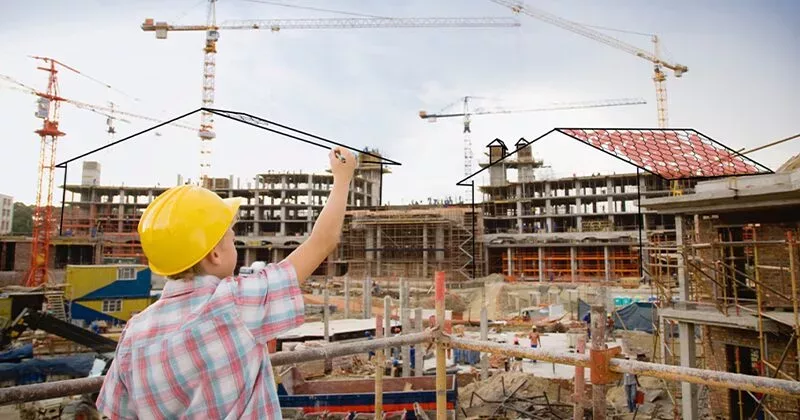11 mins read
How To Master The Construction Bidding Process

Navigating the construction bidding process can feel like tackling a massive, intricate puzzle with high stakes. Whether you’re a seasoned contractor or a rookie looking to get into the field, learning this skill could be the difference between getting profitable contracts and letting chances slip through your fingers.
Bidding in construction management is more than simply putting a figure out there and crossing your fingers; it is a delicate dance requiring accuracy, strategy, and a thorough grasp of both the project and the competitors. In this blog, we’ll go over the main procedures, critical insights, and insider secrets that will help you fine-tune your strategy and confidently submit winning bids.
Ready to step up your bidding game? Let’s dive in!
What is Construction Bidding?
Construction bidding is the process by which contractors and construction companies submit offers for managing or overseeing construction projects. This competitive approach enables project owners to get numerous pricing estimates and work plans from several vendors.
Typically, construction bid management starts when project owners submit bid papers or requests for proposals (RFPs) outlining project parameters, dates, and criteria. Contractors then review these papers, estimate prices, assess risks, and submit a proposal that includes specifics such as the project timetable and budget. The project owner evaluates the bids and chooses the contractor whose proposal best meets their price, timetable, and project quality requirements.
This strategy assures a fair and transparent bidding process in construction, stimulating competition among businesses, which may reduce prices and promote greater quality solutions. Bidding procedures may differ depending on the type of construction project; public projects often have stronger controls than private ones, guaranteeing adherence to legal and ethical standards. While the lowest offer is often preferred, project owners may also evaluate expertise, project strategy, and contractor dependability. The goal is to establish a compromise between affordability and ensuring that the project is finished properly, on schedule, and under budget.
Common Challenges of Construction Bidding
When it comes to bidding strategies in construction, owners and bidders often face several challenges. Here’s an in-depth look at frequent issues experienced by them:
Owner Challenges
Balancing Cost and Quality
Owners are sometimes tempted to choose the lowest proposal to decrease project expenses, but this is fraught with risk. Lower bids may not contain high-quality materials or efficient processes, thus raising future expenses due to maintenance or redesign. Achieving a balance between upfront costs and quality requires a comprehensive assessment of both the contractor’s skills and proposed methodologies.
Incomplete or ambiguous bids
When contractors submit bids that are vague or lacking detail, owners struggle to determine how well the bidder knows the project’s intricacies. Ambiguous bids may lead to misconceptions about the project scope or budget, as well as delays in timelines. A precise and open bidding procedure can help owners establish clearer expectations from the beginning.
Bid Shopping Concerns
Some owners engage in bid shopping, which involves using early bids as leverage to negotiate cheaper costs with other contractors. While this may cut costs, it often harms relationships with contractors who feel compelled to compromise their standards or underbid in order to remain competitive. Establishing ethical standards and transparent communication in bidding builds trust and long-term partnerships with dependable contractors.
Challenges That Bidders Face
High competition
Contractors are often under pressure to cut their bids in order to gain contracts, particularly in marketplaces with a high number of competitors. While this might make an offer more appealing, cheap bids risk reducing profit margins, particularly if unexpected complications develop. This challenge encourages bidders to strike a compromise between a competitive price and a realistic construction cost estimation to guarantee project profitability.
Unclear Project Scope
Bidders need precise project scopes to get reliable quotes. Contractors may underestimate or overstate their bids if they do not have accurate knowledge about the scope, project requirements, or expectations. A thorough scope from the owner allows bidders to better anticipate project requirements, lowering the risk of cost overruns or project delays.
Tight Submission Deadlines
Strict timelines in the construction project bidding process might result in hasty proposals or overlooked details, disqualifying a contractor regardless of their qualification for the job. Deadlines that allow for enough preparation time enable contractors to deliver full, accurate bids that are less likely to encounter issues during execution.
These problems underline the need for clear construction communication, fair processes, and adequate information in the bidding process for both owners and contractors.
The Construction Bidding Process Explained

The process begins with bid solicitation, from where it moves to bid submission, bid selection, contract formation, and finally, project delivery. We explain all the bidding process steps in more detail below:
Bid Solicitation
Bid solicitation is the start of the construction bidding process, in which project owners declare that they are looking for contractors to bring their project to life. It’s similar to throwing a broad net and hoping to attract attention from qualified contractors, vendors, or suppliers. This step is often preceded by a formal request for proposals (RFP), request for quotations (RFQ), or invitation to bid (ITB), each of which details the project’s scope, requirements, and any special credentials or expertise necessary.
The solicitation document often contains critical data such as timelines, design plans, materials necessary, financial limits, and even project objectives, so prospective bidders may understand the expectations from the outset. Bid solicitation is critical because it allows the project owner to explicitly specify project requirements while attracting a competitive pool of contractors capable of meeting the project’s expectations.
Bid Submission
Once contractors receive the bid request, they begin the bid submission process. Contractors provide a proposal that contains their methodology, a timeframe, a full analysis of expenses, and any unique experience they offer to the project. Preparing a bid requires careful balancing: contractors must create a bid that is both competitive in pricing and precise enough to cover all expected expenditures and risks. Many businesses devote a substantial amount of time and money to this step, assessing material prices, personnel, equipment, and possible eventualities to develop a thorough and competitive bid package.
A well-thought-out bid proposal not only highlights contractors’ credentials, but also indicates their dedication to delivering on budget, on time, and to a high level.
Bid Selection
After the bids are filed, project owners or their representatives proceed to the bid selection process, where they examine and compare each proposal. This is more than simply getting the lowest price; owners want a bid that offers the most value within their budget. They assess expertise, prior performance, project timing, financial stability, and the contractor’s attitude to quality and safety.
This process is often demanding and may include interviews, background checks, or even requests for further information to explain certain aspects of the proposal. The aim is to choose a contractor that not only fits the budgetary criteria but also has a proven track record and the necessary competence to effectively finish the project. Making the appropriate decision here is crucial to putting the project on track for success while reducing the risks associated with employing an unfit contractor. Supporting yourself with professional bid management software is an excellent way to streamline the process with the help of technology.
Contract Formation
Once the project owner has selected a winning proposal, both parties move to contract formation, which formalizes the project’s conditions. This step involves creating and executing a legally enforceable contract that describes each party’s duties and rights, including payment schedules, deadlines, deliverables, and performance expectations. Timelines, payment terms, fines for delays, construction warranties, and conditions for dealing with modifications or unanticipated issues throughout the project are all common components. The contract also includes dispute resolution procedures and reasons for termination, providing a safety net for all parties involved.
Crafting a complete contract is vital because it reduces ambiguities that might lead to future issues. By finalizing this document, the project owner and contractor align their expectations and create a clear structure for the work ahead.
Project Delivery
Project delivery is the phase in which construction activity starts, bringing all the preparations to completion. The contractor now completes the project following the contract’s requirements, which frequently begins with mobilizing resources, acquiring appropriate permissions, and working with subcontractors and suppliers. Construction project collaboration is critical throughout this stage, as project managers, owners, and contractors must keep on track, resolve any emergent issues, and ensure that work is completed on time.
The project owner often performs frequent inspections or check-ins to ensure that milestones are completed, quality standards are upheld, and any concerns are handled as soon as possible. To guarantee that the project is finished on schedule, under budget, and in accordance with the quality standards specified in the contract, a combination of competent labor, efficient resource management, and good communication is required. A final inspection validates that all elements fulfill the agreed-upon requirements, moving the project from planning to a finished, concrete result.
How To Be Successful in The Construction Bidding Process

Here are some key elements to consider when putting together bids that will win the project.
Review Everything
Creating an accurate bid is arguably the most important aspect of this process. To avoid inaccuracies, every piece of documentation in the bid package needs to be thoroughly reviewed. This ensures that all project requirements and construction specifications have been met, helping to prevent oversights that could derail your proposal.
Rushing through this step to meet tight deadlines is a common mistake that can lead to expensive errors. Implementing a comprehensive review system, complete with a checklist of key items and specifications, helps you stay organized and on track, making it easier to catch potential mistakes before they escalate.
Ensure Your Predicted Costs, Productions, and Quantifications Are Accurate
The calculations and formulas that go into creating a bid are complex and multifaceted. To determine an accurate cost estimate, these calculations need to be as watertight as possible. Errors in these calculations can lead to reworking bids, disappointing clients, or financial losses.
Leveraging advanced estimating software can significantly reduce this risk, as these tools streamline data input and analysis. By feeding accurate data into tools like RIB Candy software, contractors gain the insights needed to bid confidently and manage projects effectively from conception through to completion.
Be Consistent
Consistency is another cornerstone of successful bidding. Keeping your coding, format, costs, formulas, and processes consistent can help to achieve more reliable and efficient bids. This also facilitates smoother communication and presents a cohesive, professional image to clients.
Leverage Past Data
Having an existing database of past bids can speed up the construction bidding process and improve accuracy. Rather than piecing together data from disconnected spreadsheets, a centralized, cloud-based system can store and manage all relevant data in one place. This not only saves time and effort but fosters better collaboration among team members and streamlines future bids.
Understand the Project Site
Failing to visit or inspect the building site before submitting a bid can lead to inaccurate estimates. Essential details about the site, such as the need for specialized equipment or additional preparations, can be overlooked if the site wasn’t visited before the bid. A comprehensive site management strategy ensures that your bid reflects the true scope of the project, preventing costly surprises later on.
Develop Strong Communication Channels
Clear and proactive communication with project stakeholders is critical throughout the bidding process. Establishing strong channels of communication ensures that any queries or ambiguities regarding the project are immediately handled, reducing misconceptions and enabling your proposal to completely fit with the project owner’s vision. This collaborative approach distinguishes you from the competition by demonstrating your attention to detail and dedication to the project.
Stay Current on Industry Trends
Keeping up with current industry trends, material pricing, and labor rates could give you an advantage in the competitive bidding process for construction projects. Market swings may have a significant impact on your estimated costs and schedules, so including current data in your bids improves their accuracy and attractiveness. This adaptability not only demonstrates your expertise but reassures clients of your commitment to delivering a realistic and reliable project plan.
Prioritize Bid Security
Bid security is a crucial aspect of the construction bidding process since it demonstrates a contractor’s commitment and trustworthiness to complete the project if granted. Bid security, which is often supplied in the form of a bid bond or deposit, ensures project owners that the contractor is serious and financially capable of carrying out their commitments. It also protects project owners from having to restart the bidding process if the chosen contractor withdraws. Including bid security in your proposal demonstrates professionalism and confidence, distinguishing your offer as a dependable and trustworthy option.
Final Thoughts
As we have learned, accurate and efficient bids are key to enhancing any construction business. With cloud-based estimating software like RIB Candy, you can access information faster, create more consistent and accurate calculations, and manage the bidding process with greater efficiency.
Are you ready to up your construction bidding game? Experience the power of RIB Candy and get your free demo today!

Most Recent
11 mins read
10 mins read
10 mins read
29 mins read
Blog Categories

Ebook











